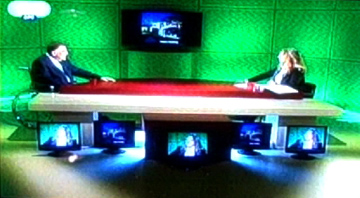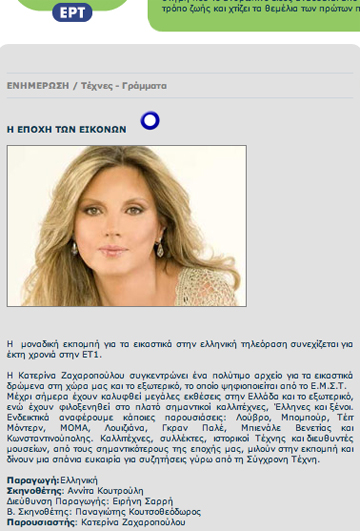
Television: the small screen, the idiot box, the tube, the boob tube, or the box. With all that’s on television nowadays, Katerina Zacharopoulou presents The Age of Images – a 60-minute weekly TV program on contemporary art. Airing since 2003 on ET1, a state-owned TV channel, it has proven to be the remedy to my chronic skepticism about art on television.
To this day, The Age of Images remains the only TV program in Greece that follows Greek artists at major national and international exhibitions. The program records and archives the contemporary art scene via current art events. In six years, Zacharopoulou has presented and introduced to the general public some of the most influential Greek and international artists including Janis Kounellis, Marina Abramovitz, Gilbert & George, Richard Long, Jan Fabre, Peter Greenaway, Joseph Kosuth, Tony Cragg, Bill Viola, Sophie Calle, Tony Oursler, Christian Boltanski, Ghada Amer, Nikos Navridis, Kostas Tsoklis, Pavlos, Alecos Fassianos, as well as leading curators such as Rosa Martinez, Robert Storr, Dan Cameron, Missimiliano Gioni, Denys Zacharopoulos, Anna Kafetsi, and Hou Hanru. The show has extensively covered the programming at the Louvre, MoMA, Grand Palais, Palazzo delle Esposizioni, as well as the Venice and Istanbul Biennials. In short, Zacharopoulou has covered over 150 exhibitions of contemporary art.
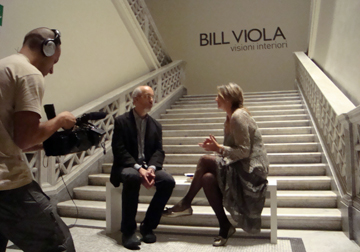
Interestingly, Zacharopoulou was initially trained as a painter. In the early 90s she attended a series of art educational seminars on contemporary art at the Centre Georges Pompidou in Paris directed at children and young adults. Driven by the language in contemporary art as a vehicle of communication, and by the role of the artist as mediator of knowledge and experiences she began experimenting with television in 1993 . Good Afternoon Mr. Picasso, on ET1 was a children’s weekly program, which presented twenty-four artists’ portraits spanning from the Renaissance to the 20th century. Innovative graphics and animations drew children to the visual arts and acquainted them to what otherwise would not have been introduced to at school. Between 1995 and 1999 on SEVEN-X TV Channel, Zacharopoulou presented a program on visual arts where she spoke with Greek artists such as Blasis Kaniaris, Nikos Kessanlis, Chryssa Romanou, Kostas Tsoklis, Pavlos, Yeoryios Lappas, Nikos Navridis, Alexandros Psichoulis, among others. The show was called Art-Fil. Next came a collaboration with the publishing house Kastanioti to produce a CD-ROM called Arts station, promoted through her program With paper and a Mouse, airing on ET1 in 2000. Programming that reflected the times and interests of children seemed an ideal solution to inspiring them. Art Show followed on NET TV Channel, a one-hour program exploring the relationship between art and fashion.
Finally, I got to see Katerina Zacharopoulou in action at the set of The Age of Images. She is a warm, approachable, and composed host of gentle and hospitable demeanor.
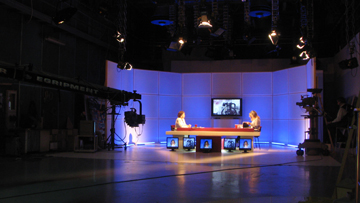
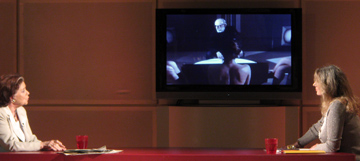
Maria Karavia was the guest that day, known as a pioneer of cultural and art programs on Greek Television some years ago. Mrs Karavia had studied Art History and worked for the Greek Service of the BBC World during the dictatorship in Greece. Karavia is an accomplished author, whose name is closely associated with Greek art at large.
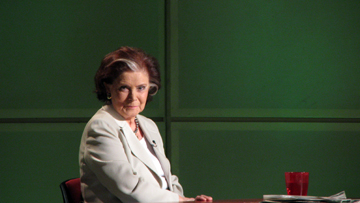
It was a pleasure being on the set that day, seeing two generations of Greek art TV hosts meet and swap stories.
The following is my recent interview with Katerina Zacharopoulou:
Georgia Kotretsos: You’ve been in conversation with acclaimed Greek and international artists, curators and collectors for six years now on The Age of Images set. Overall for nearly two decades, your need to converse has taken various forms, by targeting different age groups at a time – thus I’m curious to find out what has taken you as an artist down this parallel career path?
Katerina Zacharopoulou: Television seemed to be an interesting medium, which I could make art accessible to children, I was hopeful enough to perceive it as an educational vehicle. Good Afternoon Mr. Picasso first aired in 1993 on ET1, and served as a children’s studio – where there was put emphasis on the value of children’s art and the role of the child as an artist. I had extensive training in art education and sufficient previous experience off camera that allowed me to pursue such a program on that scale. To my surprise soon after, I was approached by a private TV channel, SEVEN-X to present a talk show, where I’d converse with professional artists about their work. It was an exciting parallel activity in terms of making a livelihood as we are all familiar with the struggles and difficulties of our profession in that department. I felt at ease right away, it felt natural, I forgot the cameras and got to work – trying to distinguish and further unfold the private and public persona of the artist across from me. One thing led to another and since 2003 I’m presenting at ET1 The Age of Images. My work gives me immense pleasure and satisfaction — coming face to face with different personalities of Artists, one at a time while figuring out what that means in its case individually. I’m interested in the idea of the artist as the mediator where the visual image can and is communicated.
I see the body of these interviews as a work in progress in terms of my own practice. I recently began thinking of them in terms of my own work and how that intense journey is reflected in my practice today. It’s interesting to note that two years ago at the Bernier/Eliades gallery in Athens, I showed a video work entitled 6-minutes about where I interviewed myself, going back to the idea of the public/private persona of the artist, which I’m poorly discussing right now but I’m bringing it up cause it’s important for my own practice to see how my two roles came together without evidence of collision.
GK: Typically, TV would be the medium to avoid for the kind of program you present, yet you have managed to lure the average TV viewer to the art world through The Age of Images, while maintaining the quality of conversation at a level anticipated by the art audience and by continuing to stimulate an engaged dialogue within the Greek and international art community. What are the pros and cons of the TV as a medium when it comes to art?
KZ: TV is a prevalent and simultaneously a public platform perfectly fitted for educational and cultural ventures and initiatives. The challenge has been communicating contemporary art to the uniformed viewers without compromising the art language. I intentionally did not negotiate the parameters of language — I find it contrary to the nature of art to adapt to jejune modes of communication hoping to reach more viewers. One thing worth mentioning in this regard is that the flow of conversation is interrupted by TV commercials, which affect both the discussion per se and the experience of the viewer at home. Overall The Age of Images through the TV makes contemporary art accessible to the boarder public and it is particularly optimistic that viewers have followed art through this programs despite the specialized language used in the discussions.
GK: The Age of Images is archived at the State Television Channel and in digital form at the National Museum of Contemporary Art (EMST) in Athens, Greece. Do you see value in commercially producing a DVD series of The Age of Images interviews, which could then easily be part of any library, studio or office of any art professional around the world?
KZ: There is immense value in the prospect of commercially producing a series of DVDs but that would require appropriate permissions from the ET1 TV Channel. Also, now that I’m thinking about it, if selected thematically and re-edited to create a focused series on a variety of subjects – it would be ideal for libraries, seminar classes and other educational purposes. I hope to do this some day. Possibly ERT, would be in interested in investing in such an ambitious project. It could also be funded and produced by an alternative public or private sector. The exciting thing is that in 2009, ET1 will create a website where The Age of Images program will be available online.
Don’t miss tonight’s show at 6pm – Zacharopoulou will be talking to Greek collector E. Emfietzoglou.

